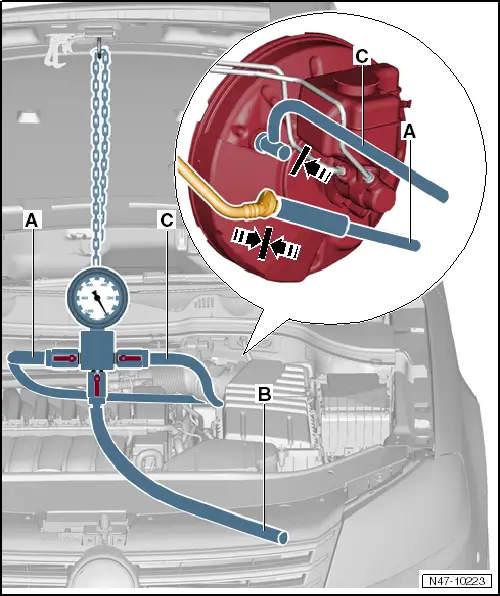Audi Q7: Vacuum System, Checking
Tests and Test Requirements
Special tools and workshop equipment required
- Brake Servo Tester -VAS6721-
The following checks will be helpful when performing Fault Finding in case of complaints regarding the brake booster or the so-called "hard brake pedal".
The following components are included in the check:
- Brake booster
- Gasket between the brake master cylinder and the brake booster
- Check valve
- Vacuum hoses with connectors
- Vacuum pump (if equipped)
 Note
Note
Keep the geographical surrounding in mind when evaluating the measurement results. The higher above sea level, the lower the air pressure.
Note the test requirements:
- Visually inspect all of the vacuum hoses for damage (for example, tears or damage caused by animals) and secure fit
- Clean the engine compartment before starting work, if necessary
- Maintain clean working conditions when working on the vacuum system
Brake Booster Tester, Connecting
- Remove the vacuum hose from the brake booster.
 Note
Note
Pressing the brake pedal a few times beforehand makes it easier to remove the vacuum hose.
- Connect the Brake Servo Tester -VAS6721-.


- Connect the Brake Servo Tester -VAS6721- hose -A- to the vacuum hose and push the adapter -C- into the brake booster.

Vacuum, Checking
 Note
Note
- The average earth atmospheric air pressure at sea level (N. N.) is 1013 mbar (14.69 psi) and it decreases dramatically at higher altitudes (approximately 100 mbar (1.45 psi) every 1000 meters (0.62 mile) higher) Local and time fluctuations also influence the vacuum.
- A cold engine, the A/C switched on and even only the engine idling can negatively influence the vacuum.
- Connect the Brake Servo Tester -VAS6721-. Refer to → Chapter "Brake Booster Tester, Connecting".
- Open the shut-off valve -A-.
- Close the shut-off valves -B and C-.
- Start the warm (above 60 ºC (140 ºF) ) engine and press the accelerator pedal one time quickly (engine speed higher than 2,000 RPM).
- Read the displayed measured value.
- Normally (see note), the vacuum should be between 600 and 950 mbar (8.7 and 13.77 psi) (depending on the engine installed).
Check the vacuum system for leaks if the measured value is not reached, even though all requirements (see notes) are met.
- Create a vacuum using the Hand Vacuum Pump -VAS6213- for comparison purposes. Refer to → Chapter "Vacuum, Creating with Hand Vacuum Pump".
 Note
Note
Opening the shut-off valve -B- makes it easier to remove the hose connections and the adapter.

Leak Test
- Connect the Brake Servo Tester -VAS6721-. Refer to → Chapter "Brake Booster Tester, Connecting".
- Open the shut-off valve -A-.
- Close the shut-off valves -B and C-.
- Start the warm (above 60 ºC (140 ºF) ) engine and press the accelerator pedal one time quickly (engine speed higher than 2,000 RPM).
Normally (see note), the vacuum should be between 600 and 950 mbar (8.7 and 13.77 psi) (depending on the engine installed).

- Open the shut-off valve -C- to evacuate the brake booster.
- Turn off the engine.
- Read the displayed measured value and write it down.
- The vacuum may drop 400 mbar (5.8 psi) in 12 hours.
 Note
Note
The vacuum will drop considerably within a few seconds if there are large leaks.
- If the pressure drop is large, look for the area with the leak:

A - Testing the Vacuum near the Brake Booster
- Close the shut-off valve -A- after creating the vacuum to check the brake booster vacuum system.

B - Testing the Vacuum near the Check Valve, Vacuum Hoses with Connectors and Vacuum Pump/Intake Manifold
- Close the shut-off valve -C- after creating the vacuum to check the vacuum system of the Brake Servo Tester -VAS6721- up to the intake manifold or up to the vacuum pump.
 Note
Note
Opening the shut-off valve -B- makes it easier to remove the hose connections and the adapter.

Vacuum, Creating with Hand Vacuum Pump
Special tools and workshop equipment required
- Hand Vacuum Pump -VAS6213-
Procedure
In certain situations, the vacuum can be created using a Hand Vacuum Pump -VAS6213- instead of using the engine or a vacuum pump.
- To do so, connect the Hand Vacuum Pump -VAS6213- to the vacuum hose on the connection -B- on the Brake Servo Tester -VAS6721-.
- Open the shut-off valve -B-.
- Create the vacuum using the Hand Vacuum Pump -VAS6213- until a vacuum between 600 and 950 mbar (8.7 and 13.77 psi) is displayed on the Brake Servo Tester -VAS6721-.
- Then perform the relevant tests.


